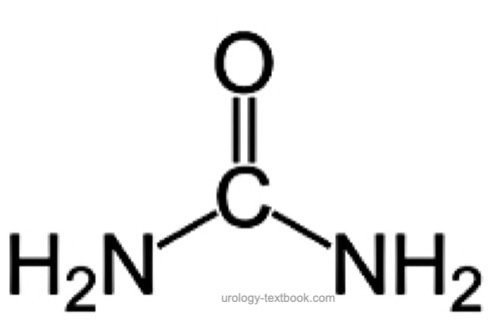You are here: Urology Textbook > Urologic examinations > Blood tests > Urea
Urea – Serum Blood Test
Urea is the end product of protein and amino acid metabolism. The urea cycle in the liver converts highly toxic ammonia to urea for excretion with the urine.
 |
Standard value:
10–50 mg/dl (1,7–8,3 mmol/l).
Blood urea nitrogen (BUN)
BUN measures the amount of urea nitrogen found in blood. BUN is easily calculated from the urea concentration: multiply urea in mg/dl with 0,467. The urea concentration and BUN in mmol/l are identical.
Laboratory test method:
Spectrophotometry.
Indications:
Estimation of protein metabolism (anabolic, catabolic). Acute renal failure and chronic kidney disease. The routine measurement of creatinine and urea is often unnecessary. With relatively good renal function, the urea concentration is subject to higher fluctuations compared to creatinine and is therefore not helpful as a kidney function parameter. In preterminal renal insufficiency, however, the urea concentration is helpful to assess residual kidney function.
Differential Diagnosis of Elevated Urea
- Acute kidney injury and chronic renal insufficiency.
- Nonrenal causes of elevated urea concentrations are exsiccosis, high-protein diet and catabolic metabolic situations such as trauma, fever and hunger.
Differential Diagnosis of Low Urea
Malnutrition, hepatic insufficiency.
| Cystatin C | Index | C-reactive Protein |
Index: 1–9 A B C D E F G H I J K L M N O P Q R S T U V W X Y Z
References
Guder, W. G. & Nolte, J. Das Laborbuch für Klinik und PraxisUrban + Fischer, 2009
Siegenthaler 1988 SIEGENTHALER, W. ; SIEGENTHALER, W. (Hrsg.): Differentialdiagnose innerer Krankheiten.
Georg Thieme Verlag, Stuttgart, New York., 1988
 Deutsche Version: Harnstoff Laborwert
Deutsche Version: Harnstoff Laborwert
Urology-Textbook.com – Choose the Ad-Free, Professional Resource
This website is designed for physicians and medical professionals. It presents diseases of the genital organs through detailed text and images. Some content may not be suitable for children or sensitive readers. Many illustrations are available exclusively to Steady members. Are you a physician and interested in supporting this project? Join Steady to unlock full access to all images and enjoy an ad-free experience. Try it free for 7 days—no obligation.
New release: The first edition of the Urology Textbook as an e-book—ideal for offline reading and quick reference. With over 1300 pages and hundreds of illustrations, it’s the perfect companion for residents and medical students. After your 7-day trial has ended, you will receive a download link for your exclusive e-book.